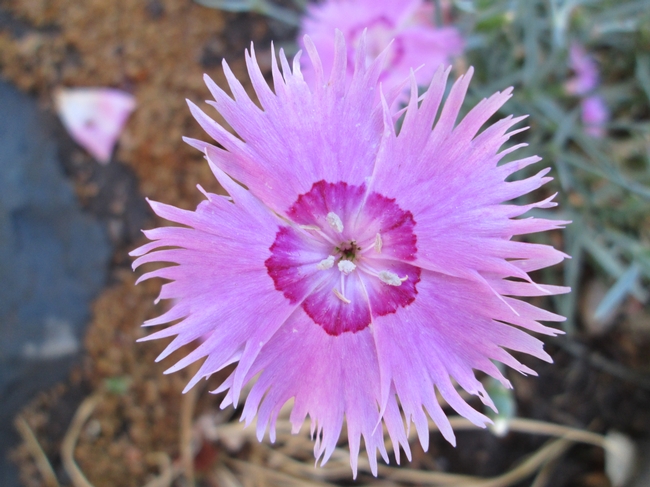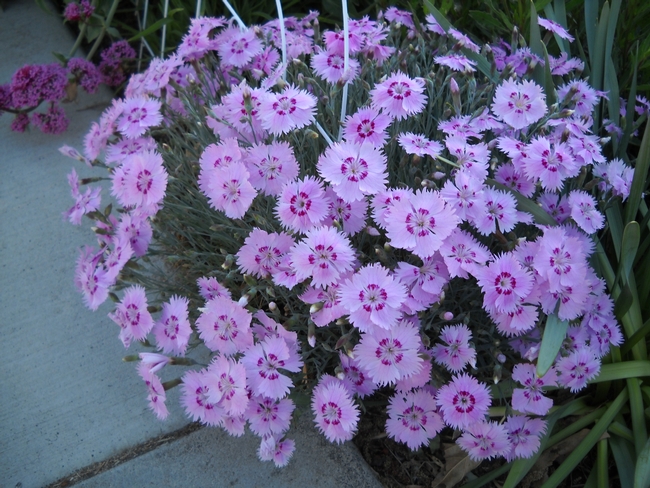- Author: Alison Collin
Some of the most rewarding plants that I have grown in recent years came from a packet of “Cottage Pink” seeds (Parks Seed Co.) which I ordered for no other reason than I needed a small purchase to get free shipping on a vegetable order!
These pinks, Dianthus plumarius, are traditional cottage garden flowers from Europe where they have been cultivated for hundreds of years. They belong to the Dianthus genus which contains over 300 species together with numerous hybrids including such favorites as carnations and Sweet Williams.
I planted the seeds in late winter and had an exceptionally high germination rate. I was careful not to overwater the seedlings, and they grew well and transplanted easily. Although perennials, they all flowered in their first year.
Cottage pinks are characterized by perennial mats of gray needle-like foliage up to 12 inches wide, although the growth habits of individual plants are not completely consistent, some being very tightly growing while others are more lax. Strongly perfumed single flowers in shades of pink or white with varying petal structure and flower patterns are held upright on 6”-8” stems. These are long lasting, and each flower has a couple of dormant buds immediately beneath it which provides a long flowering season which lasts, with regular deadheading, from April to September in the Owens Valley. They don't flop, and so far I have never had any pests or diseases bother them.



All my plants have now survived several winters in Bishop (USDA Zone 7b), but just one of the plants goes extremely brown in winter and looks as though it has died, only to come back very vigorously when the temperatures rise, although that particular one blooms later than the rest.
My only problem was that until they flowered I did not know which would produce the most interesting flowers, and since I had run out of space in the borders I was forced to plant them out in the vegetable garden!
Some nurseries carry named varieties, often heavily marked or with stronger colors e.g. 'Firewitch', or related species such as Dianthus gratianopolitanus, and D. Alwoodii both of which perform well.
Cottage Pinks are hard to beat – long bloom season, perfume, good cut flowers, neat foliage and not prone to pests and diseases. I highly recommend them!
by Alison Collin
If ever there was a plant designed to live in the high desert areas of the Owens Valley, it must surely be Iris unguicularis, a small rhizomatous iris native to hot, stony areas of Turkey, Tunisia and Greece. They will grow in sandy, stony alkaline soils with a pH of above 7.5, like hot summers, have low irrigation requirements, and flower in the winter. What more could we want?!
They are hardy to about -10°F although they pause in the blooming cycle when the temperature reaches 15°F. In the winter of 2014-2015, the flowers on one of my plants were frosted when the temperature dropped to 11°F, but it was soon in flower again.
The plants are rather slow to become established, but eventually produce low clumps, up to 18 inches across, of narrow, arching, evergreen leaves about 18” length. The violet/blue flowers which have a yellow stripe on the falls are produced in waves from late autumn to early spring and just clear the foliage, at about 1 foot in height. They are fragrant, and can be cut in bud and will open in water where their perfume may be enjoyed at close range.

The foliage can become a little untidy at times, and some people recommend cutting the foliage short in the fall so that the flowers will show up better, but in any case any brown or dying leaves should be removed. Although not prone to disease the one downside is that slugs and snails love the flowers so if you have a problem with these you will need to address it.
When so many of our plants in the Owens Valley are very dormant during the depths of winter, it is refreshing to see a rare splash of color on these brave little plants.




